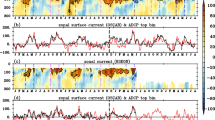Abstract
Current meter data from a 411-day study are used to characterize the movement of water through Tavernier Creek, a tidal channel in the Upper Florida Keys that connects northeastern Florida Bay with the narrow continental shelf on the Atlantic Ocean side of the Keys. The record reveals active tidal and nontidal exchanges. Strongest flood and ebb current speeds commonly reach 50 cm s−1. Low-frequency exchanges are highly coherent with the across-shelf component of local wind stress over time scales in excess of 2.5 days. Bay-shelf exchanges are investigated in four ways. Current measurements made while a drogue was tracked from one end of the creek to the other provide a relationship that can be applied to the time series of current meter data. Results suggest that ocean water reaches the bay end of the creek on 92% of the floods, and bay water reaches the ocean end on 94% of the ebbs. The Eulerian tidal excursion calculated from the amplitude of the M 2 tidal constituent is 1.42 times the length of the channel, and half-tidal cycle Eulerian displacements are commonly 1.5 times the length of the channel. Salinity measurements over a 165-day period document the arrival of bay and ocean water at a study site at about the midpoint of Tavernier Creek. Results suggest that the creek becomes completely flushed after about 450,000 m3 of water have entered from either end. Histograms of ebb and flood volume transports indicate that half-tidal cycle transports are commonly between 800,000 and 1,100,000 m3. The long-term movement of water through Tavernier Creek is a net outflow from Florida Bay. Results support the idea that Tavernier Creek serves as an effective conduit for exchanging bay and ocean water, and especially for draining the northeast corner of Florida Bay.







Similar content being viewed by others
References
Bloomfield P (1976) Fourier analysis of time series: an introduction. Wiley, New York
Lee T, Smith N (2002) Volume transport variability through the Florida Keys tidal channels. Cont Shelf Res 22:1361–1377
Little J, Shure L (1988) Signal processing tool box for use with Matlab, user’s guide. The MathWorks Inc, Natick
Millero FJ, Poisson A (1981) International one-atomosphere equation of state of seawater. Deep-Sea Res 28A:625-629
Pitts P (1994) An investigation of near-bottom flow patterns along and across Hawk Channel, Florida Bay. Bull Mar Sci 54:610–620
Pitts P (2002) Tidal and wind-driven circulation through Lignumvitae Basin, Florida Bay. Gulf Mex Sci 1:75–85
Porter J (2002) Introduction. In: Porter J, Porter K (eds) The Everglades, Florida Bay and coral reefs of the Florida Keys: an ecosystem sourcebook, CRC, Boca Raton, pp 1–16
Schureman P (1958) Manual of harmonic analyses and prediction of tides. Spec. Publication No. 98, rev. ed., U.S. Govt. Printing Office, Washington, D.C., 317 pp
Smith N (1990) Wind domination of residual tidal transport in a coastal lagoon. In: Cheng R (ed) Residual currents and long-term transport, coastal and estuarine studies 38. Springer, Berlin Heidelberg New York, pp 123–133
Smith N (1994) Long-term Gulf-to-Atlantic transport through tidal channels in the Florida Keys. Bullet Mar Sci 54:602–609
Smith N (1997) An introduction to the tides of Florida Bay. Fla Sci 60:53–67
Smith N (1998) Tidal and long-term exchanges through channels in the Middle and Upper Florida Keys. Bull Mar Sci 62:199–211
Smith N (2000) Transport across the western boundary of Florida Bay. Bull Mar Sci 66:291–303
Wu J (1980) Wind-stress coefficients over sea surface near neutral conditions—a revisit. J Phys Oceanogr 10:727–740
Acknowledgments
My thanks to Patrick Pitts for his help in the installation, recovery, downloading, editing and archiving of the data used in this study. Funding was provided by the National Oceanic and Atmospheric Administration’s National Undersea Research Center at the University of North Carolina at Wilmington pursuant to NOAA award number NA36RU0060, and by the National Park Service pursuant to Cooperative Agreement CA 5280-4-9022. Harbor Branch Oceanographic Institution contribution 1604.
Author information
Authors and Affiliations
Corresponding author
Additional information
Responsible Editor: Alejandro Souza
Rights and permissions
About this article
Cite this article
Smith, N.P. Transport through Tavernier Creek: a primary flushing pathway for Northeast Florida Bay. Ocean Dynamics 55, 449–457 (2005). https://doi.org/10.1007/s10236-005-0026-1
Received:
Accepted:
Published:
Issue Date:
DOI: https://doi.org/10.1007/s10236-005-0026-1




